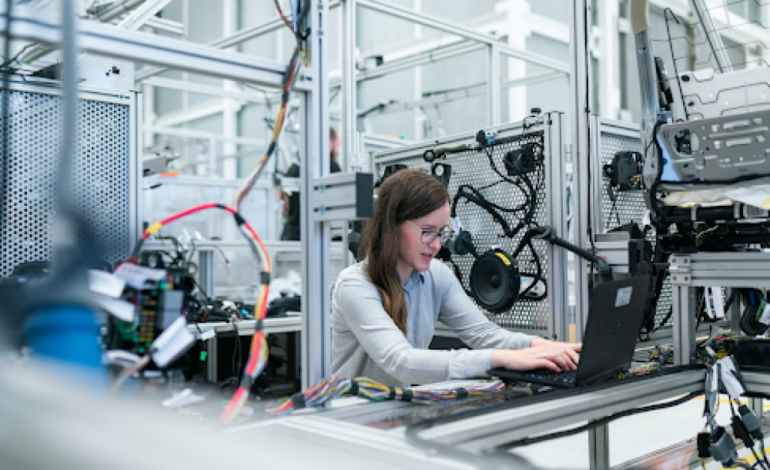Artificial Intelligence-based Solutions for Manufacturing: The Complete Guide

As technology continues to evolve, more and more companies are turning towards using artificial intelligence-based solutions for their manufacturing processes.
AI-based solutions offer many benefits, such as increased efficiency and cost savings. However, it can be difficult to know where to start when implementing these solutions in a manufacturing setting.
This blog post provides a comprehensive guide on how to use AI-based solutions for manufacturing. We will discuss the types of AI available, the specific applications that they can be used for in the manufacturing industry, and the potential advantages that come with them.
Additionally, we’ll provide advice on how you can best implement these technologies in your organization so you can reap all the rewards they have to offer.
So whether you are running a large manufacturing facility or just starting, this guide will help you make the most of AI-based solutions.
Understand Different Types Of AI
The first step to incorporating AI into your manufacturing process is understanding what types of AI are available. The two main categories are supervised learning and unsupervised learning.
Supervised learning uses labeled data that has been collected in previous experiments to train algorithms to recognize patterns and predict future outcomes. Unsupervised learning involves training an algorithm with unlabeled data so it can detect patterns and anomalies without any prior knowledge.
Both types of algorithms have their strengths and weaknesses, so it’s important to choose the right type for your specific needs.
For instance, if you’re looking for a way to increase production efficiency, supervised algorithms may be more appropriate. These can be used to detect bottlenecks or areas of inefficiency and help identify solutions quickly.
On the other hand, unsupervised learning can be used to detect anomalies in processes that may otherwise go unnoticed – such as rogue equipment or mislabeled parts.
Identify AI Applications For Manufacturing
Once you understand the different types of AI available, it’s time to consider which applications might be most beneficial for your organization.
There are a variety of ways AI can be employed at a manufacturing facility – from simple automation solutions to complex predictive models that help optimize production and reduce errors.
At the most basic level, AI-based analytics can be used to monitor machines and processes in real-time and quickly identify problems before they become costly issues.
This helps reduce downtime and keep production running smoothly. Also, by using analytics in manufacturing, you optimize your manufacturing process and anticipate potential obstacles before they arise.
These powerful analytics solutions can consider a wide variety of factors – such as time and cost constraints – when making decisions about production scheduling or inventory management. With the right predictive analytics model in place, you can ensure that your product is always delivered on time while still maintaining a high-quality product.
Implement AI Solutions
Now that you have a better understanding of the types of AI available and how they can be applied to manufacturing, it’s time to start implementing these solutions. Depending on your needs, you may want to start by introducing automation into your production line or implementing an analytics solution that monitors and predicts future outcomes.
You’ll also want to consider investing in the right infrastructure for your AI-based solution – such as powerful computer systems with enough memory and processing power to handle large datasets and complex algorithms. Additionally, make sure you have access to reliable data sources so you can ensure accuracy and reduce errors in your results.
Finally, don’t forget to take the necessary security measures to protect your data and systems. Invest in a robust cybersecurity strategy to keep malicious actors out of your systems and safeguard proprietary information. Not only is this important for your safety, but it’s also a legal requirement in many countries.
Monitor Performance After Implementation
The last step is monitoring performance after implementing any AI-based solution. This will allow you to track how well the technology is performing and make adjustments as needed.
Create a system that tracks the performance and accuracy of your AI applications on an ongoing basis. This will help you hone in on areas for improvement and ensure that your systems are working as efficiently as possible.
Additionally, use feedback from employees who are using the technology to get their perspective on the user experience – this can provide valuable insights into where further improvements can be made.
By paying close attention to how your AI-based solutions are performing, you can ensure that they remain up-to-date and continue to deliver maximum value to your organization. Additionally, you can make sure that any new technologies or algorithms are seamlessly integrated into your existing systems.
What To Do Next?
AI is a rapidly evolving field and new technologies are emerging every day. To stay ahead of the curve, it’s important to continuously research the latest developments in AI for manufacturing and consider how they might benefit your organization.
Additionally, look into partnering with an AI provider or consultant who can help you better understand the technology and how it can be applied to your business.
Finally, don’t forget to communicate with other departments in your organization – such as IT, Finance, and HR – on how AI is being implemented across the company.
This will ensure that everyone is aware of developments and has access to current information about any changes or updates being made. By keeping everyone involved and informed, you can ensure that your AI-based solutions are being used to their full potential.
By investing in AI-based solutions, you can take your manufacturing process to the next level. From automating processes and predicting demand to monitoring performance and maintaining security, there are a variety of ways that AI can help you optimize your operations.
However, it’s important to make sure you have the right infrastructure and personnel in place so that you can fully leverage these technologies.
Additionally, by staying up-to-date on industry developments and communicating with other departments within your organization, you can ensure that everyone is aware of any changes or updates being made to your AI-based solutions
With the right approach, you can start taking advantage of AI and transforming your manufacturing business into an efficient machine. Just a little bit of effort – and help from the right technology partner – and you can make sure that your organization is well-positioned to stay ahead of the competition in an ever-evolving global market.










